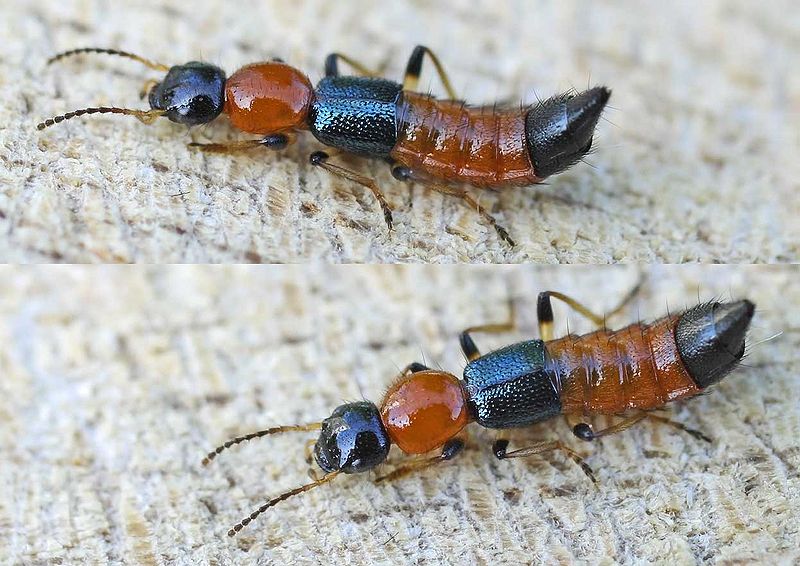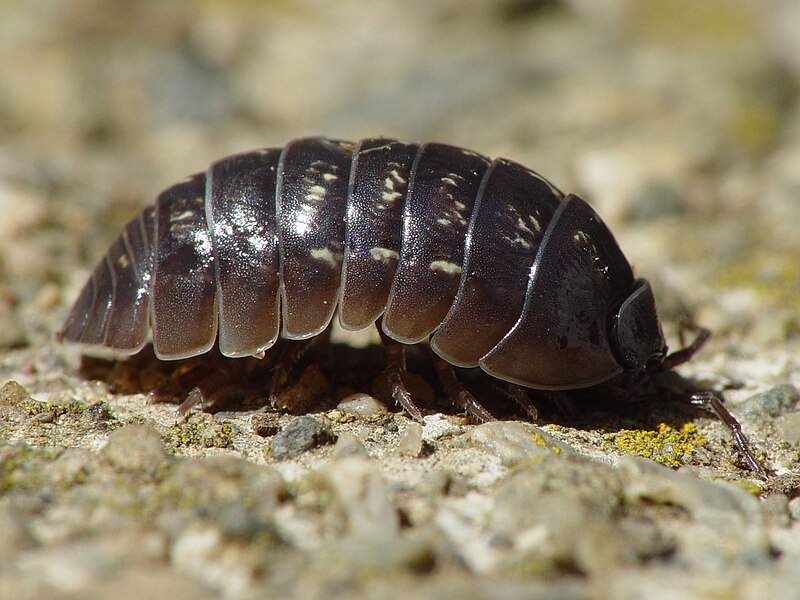Prehistoric cave paintings show that the pitfall trap, a simple covered or uncovered hole designed to capture animals, came into being very early in our evolution as a species. Indeed, they are still used by hunters and field researchers today. Pitfall traps also provide pet keepers with a simple, effective means of collecting live food for reptiles, amphibians, tarantulas, scorpions, mantids and other terrarium animals.
Building and Baiting the Trap
 To create a pitfall trap, simple bury a can or jar flush with the ground and cover it with a board that is slightly elevated by small stones. This will keep rain out while allowing invertebrates to enter.
To create a pitfall trap, simple bury a can or jar flush with the ground and cover it with a board that is slightly elevated by small stones. This will keep rain out while allowing invertebrates to enter.
An amazing assortment of creatures will simply stumble into such a trap, but you can increase its effectiveness by adding bait. A bit of ripe fruit, molasses, honey and some tropical fish flakes will lure all sorts of insects, sow bugs and other invertebrates (snails and slugs are especially fond of beer). Be sure to keep some dead leaves or paper towels in the trap as well, to provide places for your catch to hide and keep away from one another.
Boards or other cover spread about an area, which can be easily turned and checked, will also attract a variety of insects. Spraying the area with a hose during dry weather will attract increased numbers of invertebrates to these shelters.
Cautions
Always use caution when examining your catch, as potentially dangerous spiders, scorpions, hornets and other such creatures may be present. Have a good field guide on hand if you are unfamiliar with local species, and use feeding tongs to remove animals from the trap.
Native Beetles in the Terrarium
If your interests extend to native invertebrates, your trap will likely provide you with some pleasant surprises.
One of my favorite and rather frequent catches is the caterpillar hunter (Calosoma scrutator), a widespread beetle that feeds upon caterpillars and other soft-bodied insects (a relative, the forest caterpillar hunter, was imported to the USA from Europe in 1905 to battle gypsy moths). Next time I’ll write a bit more about the natural history and captive care of these colorful, interesting, but largely over-looked beetles.
Further Reading
I have long relied heavily upon wild-caught invertebrates as food for animals in both zoo and my own collections. In the past I have written about collecting leaf litter and arboreal insects, as well as devices such as termite traps and the Zoo Med Bug Napper. Please see the following articles for more information:
Collecting Leaf Litter Invertebrates
Collecting Live Food: an Entomologist’s Technique
Collecting Live Insects for Birds
Image referenced from Wikipedia and orignally posted by
 That Reptile Blog – Reptile, Amphibian and Exotic Pet Care and Information
That Reptile Blog – Reptile, Amphibian and Exotic Pet Care and Information

 April and early May is dandelion-blooming time in the northern half of the USA, and nearly every herbivorous reptile relishes its leaves and, especially, the bright yellow flowers. You can harvest this nutritious plant nearly anywhere…just be careful around homes as it is considered pest (a phenomenon that has baffled me since childhood!) and is often attacked with herbicides.
April and early May is dandelion-blooming time in the northern half of the USA, and nearly every herbivorous reptile relishes its leaves and, especially, the bright yellow flowers. You can harvest this nutritious plant nearly anywhere…just be careful around homes as it is considered pest (a phenomenon that has baffled me since childhood!) and is often attacked with herbicides. One of the simplest and most effective collecting techniques was developed by entomologists (insect scientists) who needed to sample large habitats quickly. Here it is: a white, un-patterned sheet is spread below a bush or tree, and the foliage is then beaten with a stick. That’s it!
One of the simplest and most effective collecting techniques was developed by entomologists (insect scientists) who needed to sample large habitats quickly. Here it is: a white, un-patterned sheet is spread below a bush or tree, and the foliage is then beaten with a stick. That’s it! Do not collect fireflies, “hairy” caterpillars (please see photo), and brightly colored insects that you cannot identify (due to possible toxicity). Unless you are well-acquainted with local spiders, it is best to avoid them as well…harvestmen, or “daddy long-legs”, however, are harmless.
Do not collect fireflies, “hairy” caterpillars (please see photo), and brightly colored insects that you cannot identify (due to possible toxicity). Unless you are well-acquainted with local spiders, it is best to avoid them as well…harvestmen, or “daddy long-legs”, however, are harmless. Those of us who keep the smaller varieties of insect-eating reptiles, amphibians and invertebrates (dwarf leaf chameleons, bark scorpions), or who raise the young of others (many newly-transformed frogs and baby lizards), are faced with great challenges when it comes to providing a balanced diet. Many of these animals consume dozens if not hundreds of different types of invertebrates in the wild. Yet in captivity they must get by on very limited number of commercially bred insects – pinhead crickets, fruit flies and springtails. Although vitamin/mineral supplements help, the situation is far from ideal, especially where little-studied species are concerned.
Those of us who keep the smaller varieties of insect-eating reptiles, amphibians and invertebrates (dwarf leaf chameleons, bark scorpions), or who raise the young of others (many newly-transformed frogs and baby lizards), are faced with great challenges when it comes to providing a balanced diet. Many of these animals consume dozens if not hundreds of different types of invertebrates in the wild. Yet in captivity they must get by on very limited number of commercially bred insects – pinhead crickets, fruit flies and springtails. Although vitamin/mineral supplements help, the situation is far from ideal, especially where little-studied species are concerned. The problem is particularly acute because nutritional deficiencies suffered early in life are difficult or impossible to reverse later on…reptiles and amphibians that remain small never outgrow this dilemma. Those of you with an interest in invertebrates may face similar concerns when you breed mantids and certain spiders and scorpions.
The problem is particularly acute because nutritional deficiencies suffered early in life are difficult or impossible to reverse later on…reptiles and amphibians that remain small never outgrow this dilemma. Those of you with an interest in invertebrates may face similar concerns when you breed mantids and certain spiders and scorpions. A very simple (and free!) solution to this problem lies as close as the nearest pile of decaying leaves – leaf litter invertebrates. A vast army of tiny decomposers and scavengers – ants, slugs, millipedes, sow bugs, beetles, mites, springtails, bristletails and termites – inhabit accumulated leaves in city gardens and pristine forests alike.
A very simple (and free!) solution to this problem lies as close as the nearest pile of decaying leaves – leaf litter invertebrates. A vast army of tiny decomposers and scavengers – ants, slugs, millipedes, sow bugs, beetles, mites, springtails, bristletails and termites – inhabit accumulated leaves in city gardens and pristine forests alike. Isopods, more commonly known as sowbugs, pillbugs or potato bugs, are a valuable but largely neglected food source for pet amphibians and reptiles. The over 10,000 described species are common in most habitats worldwide, and are therefore an important in the diets many creatures. Ranging in size from .02 to 20 inches, there is an isopod to fit every feeding need (public aquariums pay $600 or more each for giant, deep-sea forms, so don’t plan on feeding these to your monitor lizards!).
Isopods, more commonly known as sowbugs, pillbugs or potato bugs, are a valuable but largely neglected food source for pet amphibians and reptiles. The over 10,000 described species are common in most habitats worldwide, and are therefore an important in the diets many creatures. Ranging in size from .02 to 20 inches, there is an isopod to fit every feeding need (public aquariums pay $600 or more each for giant, deep-sea forms, so don’t plan on feeding these to your monitor lizards!).